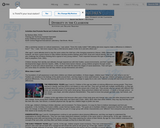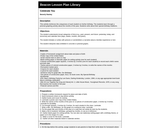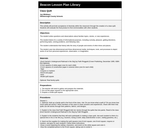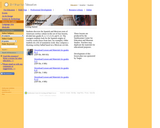
For this activity, students develop social skills and become more group-oriented by exploring the culture of their friends.
- Subject:
- Social Studies
- Material Type:
- Activity/Lab
- Provider:
- PBS
- Date Added:
- 04/26/2017

For this activity, students develop social skills and become more group-oriented by exploring the culture of their friends.

Each student will create a book about themselves using the book template. They will identify how people are similar and different.

In this lesson, students will participate in a class activity to observe their similarities and differences using the common theme of birthday celebrations. Students and their families will fill out a brief homework questionnaire about their family birthday traditions to be shared with the class. A reproducible copy of the questionnaire is included in the lesson. Students will also create a class graph of birthday months and write/draw a page for a class book about birthday celebrations.

In this lesson, students learn facts about the country of Ireland and its legends.

In this lesson, students will learn about different family traditions and holiday celebrations from around the world.

Students learn about what makes a celebration. They brainstorm celebrations they have experienced and classify them into categories. Students focus on national holidays and learn about two holidays celebrated in our national community: Veterans Day and Independence Day.

In this lesson, students compare the similarities and differences between themselves and their classmates by helping to create a class quilt. Each student will contribute a square of the quilt by drawing a picture of an important event or special time in their lives. Each student will have a turn to describe their square, then the class will examine and discuss the quilt together. The class idscussion will highlight the similarities and differences among classmates' squares.

Students will understand how their families are similar and different in respect to kinship, laws, and religion, as well as the music they enjoy, the clothing they wear, and the food they eat.

Students gain an understanding that families have similarities and differences and that members of families share the customs and traditions unique to their family.

Students explore the customs and traditions celebrated in their own homes, as well as interview invited guests to learn about other customs and traditions.

In these units, students can discover the Spanish and Mexican roots of American cowboy culture in this set of four lessons, divided into grades K–2, 3–5, 6–8, and 9–12. The youngest students look for the Spanish origins of cowboy words (lasso from lazo, for example). Older students do a bit of translation work: they compose a rhyming cowboy ballad based on a Mexican corrido.

In this lesson, students will gain knowledge about various birthday traditions from other countries around the world. The students will help the teacher make a chart of the most liked birthday traditions from the countries shared in the story.The students will also give similarities and differences they notice about birthday traditions around the world. This lesson was developed by LaToya Dawson as part of their completion of the North Carolina Global Educator Digital Badge program. This lesson plan has been vetted at the local and state level for standards alignment, Global Education focus, and content accuracy.

In this lesson, students will learn about birthdays around the world. Students will listen and learn about the diversity of people, food, games and birthday traditions globally. This lesson was developed by LaToya Dawson as part of their completion of the North Carolina Global Educator Digital Badge program. This lesson plan has been vetted at the local and state level for standards alignment, Global Education focus, and content accuracy.

Students will learn about the similarities and differences of birthday celebrations around the world. This lesson was developed by Tracey Dix as part of their completion of the North Carolina Global Educator Digital Badge program. This lesson plan has been vetted at the local and state level for standards alignment, Global Education focus, and content accuracy.

Students will review what they learned about birthday traditions and celebrations around the world. They will apply what they learned to their writings and share what they learned with their classmates. This lesson was developed by Tracey Dix as part of their completion of the North Carolina Global Educator Digital Badge program. This lesson plan has been vetted at the local and state level for standards alignment, Global Education focus, and content accuracy.

Students will learn about birthday celebrations in the Netherlands. Students will have the opportunity to play a traditional Dutch birthday game. This lesson was developed by Tracey Dix as part of their completion of the North Carolina Global Educator Digital Badge program. This lesson plan has been vetted at the local and state level for standards alignment, Global Education focus, and content accuracy.

Students will learn about Chinese birthday traditions. Students will celebrate the diversity of people, food, games and traditions globally. This lesson was developed by Leslie Montgomery as part of their completion of the North Carolina Global Educator Digital Badge program. This lesson plan has been vetted at the local and state level for standards alignment, Global Education focus, and content accuracy.

This lesson allows students to investigate birthdays around the world by using text to explore different celebrations and traditions in the world in which we live. The students will listen and learn about the diversity of people, food, games and traditions globally. This lesson was developed by Leslie Montgomery as part of their completion of the North Carolina Global Educator Digital Badge program. This lesson plan has been vetted at the local and state level for standards alignment, Global Education focus, and content accuracy.

This lesson reviews what the students have learned throughout this unit. During this lesson, the students have the opportunity to take action by writing and drawing in their journals to reflect on what they have learned about birthday celebrations around the world. The final part of this unit is for the students to share their work with the class to give their perspectives on different traditions around the world. This lesson was developed by Leslie Montgomery as part of their completion of the North Carolina Global Educator Digital Badge program. This lesson plan has been vetted at the local and state level for standards alignment, Global Education focus, and content accuracy.

Students will take action for our unit on needs and wants by starting a can food drive for our local food pantry. The students will do jobs/chores at home to earn the can food they bring in to donate.This lesson was developed by Michelle Allen as part of their completion of the North Carolina Global Educator Digital Badge program. This lesson plan has been vetted at the local and state level for standards alignment, Global Education focus, and content accuracy.